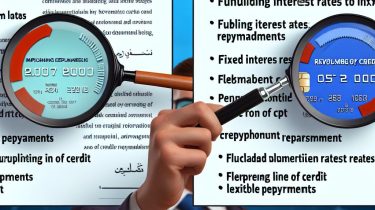Differences between term loans and revolving credit.

Understanding Term Loans and Revolving Credit
In the realm of financial products, understanding the differences between various credit options is essential for both individuals and businesses seeking effective financial management. Two common types of credit are term loans and revolving credit. Each type of credit serves distinct purposes and comes with its own set of features, repayment structures, and potential benefits. A comprehensive understanding of both can aid in making informed borrowing decisions.
What is a Term Loan?
A term loan represents a traditional credit facility where the borrower receives a lump sum of money upfront and commits to repaying it over an agreed period. This kind of loan is typically used to cover specific financial needs such as acquiring equipment, real estate, or funding a major business expansion.
Key Features of Term Loans
One of the defining characteristics of term loans is the fixed repayment period. Unlike other types of loans, term loans come with a predetermined repayment timeline that can range from a few months to several years. This predictable schedule can make financial planning easier for both individuals and businesses.
Term loans also feature interest rates that can be fixed or variable. These rates usually reflect the borrower’s creditworthiness and the duration of the loan, influencing the overall cost of borrowing. Borrowers have the opportunity to choose between a fixed interest rate, which remains constant throughout the life of the loan, and a variable interest rate, which may fluctuate over time.
An important aspect of term loans is their usage. The borrowed funds from a term loan are typically employed for a specific, predefined purpose. This makes them particularly suitable for fixed asset purchases or capital investments, where a clear financial objective is established upfront.
What is Revolving Credit?
Revolving credit, contrastingly, provides borrowers with the ability to access funds continuously up to a specified credit limit. Unlike term loans, revolving credit does not bind borrowers to a fixed repayment schedule. Instead, borrowers can draw upon the credit repeatedly, as long as the account remains open and in good standing.
Key Features of Revolving Credit
One of the principal advantages of revolving credit is its flexibility. Borrowers have the ability to access funds as needed, repay the balance, and then borrow again. This revolving capacity offers a high level of liquidity and financial flexibility that term loans do not.
The payment structure associated with revolving credit also differs significantly from term loans. Payments are generally based on the outstanding balance, which can vary each month. This stands in contrast to the fixed installments characteristic of term loans. As a result, individuals and businesses using revolving credit can manage their monthly cash flows more dynamically.
Revolving credit is commonly utilized for managing cash flow, covering short-term needs, or handling unexpected expenses. Whether it’s managing operational expenses or dealing with unforeseen financial demands, the capacity to draw, repay, and re-draw funds provides valuable flexibility.
Choosing Between Term Loans and Revolving Credit
When deciding between term loans and revolving credit, it is crucial to consider specific financial needs and circumstances. Term loans are ideally suited for financing long-term investments and acquisitions due to their structured payment plans. They provide a clear loan tenure and manageable fixed repayments, which can be beneficial for forecasting future cash flows.
In contrast, revolving credit is ideal for individuals or businesses that require episodic access to funds for short-term or ongoing operational expenses. It offers a safety net for financial exigencies, enabling businesses to address immediate financial challenges without the need for a prolonged borrowing process.
Factors to Consider
When choosing between these credit options, one must evaluate several factors, including the nature of the expenditure, the predictability of cash inflows, the variability of financing needs, and the capacity for financial management. Additionally, assessing the cost implications associated with interest rates and fees is crucial in selecting the most suitable credit option.
Applications in Real-world Scenarios
In a real-world business context, a company might opt for a term loan to finance the purchase of new machinery, given the predictability and substantial cost involved. Conversely, a retail business might prefer revolving credit to effectively manage seasonal cash flow variations, ensuring sufficient liquidity for payroll and inventory replenishment during peak demand periods.
Further Reading
For more detailed insights into term loans and revolving credit, individuals and businesses are encouraged to explore resources from financial institutions or credit advisory services. Insights from such investment educational websites offer comprehensive guides on credit options and financial planning, which can enhance decision-making processes for financial borrowers. Engaging with such resources can provide a deeper understanding of credit facilities, empowering borrowers with the knowledge to select the right product for their unique financial goals.
This article was last updated on: July 14, 2025